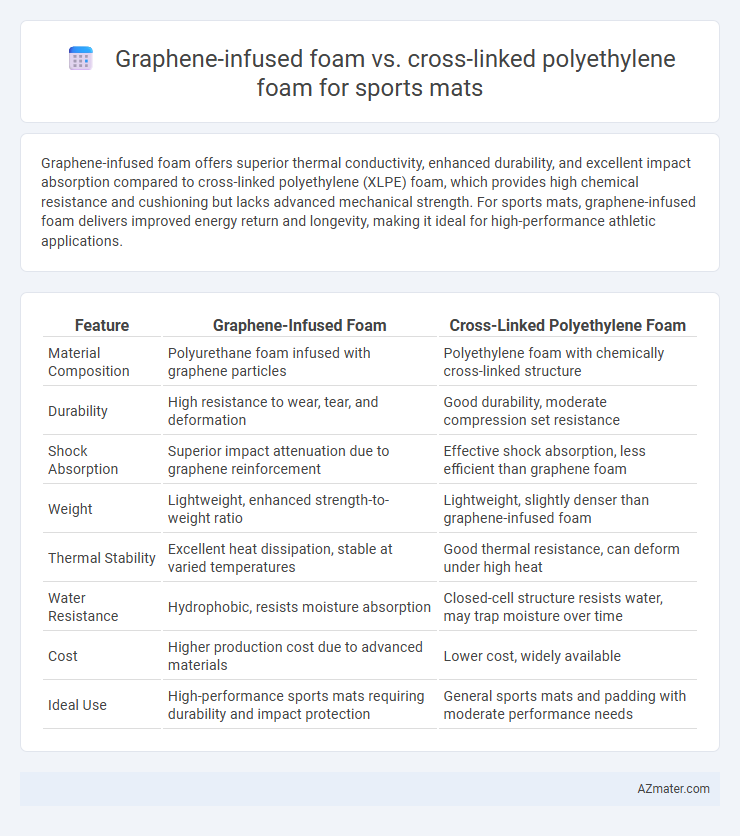Graphene-infused foam offers superior thermal conductivity, enhanced durability, and excellent impact absorption compared to cross-linked polyethylene (XLPE) foam, which provides high chemical resistance and cushioning but lacks advanced mechanical strength. For sports mats, graphene-infused foam delivers improved energy return and longevity, making it ideal for high-performance athletic applications.
Table of Comparison
| Feature | Graphene-Infused Foam | Cross-Linked Polyethylene Foam |
|---|---|---|
| Material Composition | Polyurethane foam infused with graphene particles | Polyethylene foam with chemically cross-linked structure |
| Durability | High resistance to wear, tear, and deformation | Good durability, moderate compression set resistance |
| Shock Absorption | Superior impact attenuation due to graphene reinforcement | Effective shock absorption, less efficient than graphene foam |
| Weight | Lightweight, enhanced strength-to-weight ratio | Lightweight, slightly denser than graphene-infused foam |
| Thermal Stability | Excellent heat dissipation, stable at varied temperatures | Good thermal resistance, can deform under high heat |
| Water Resistance | Hydrophobic, resists moisture absorption | Closed-cell structure resists water, may trap moisture over time |
| Cost | Higher production cost due to advanced materials | Lower cost, widely available |
| Ideal Use | High-performance sports mats requiring durability and impact protection | General sports mats and padding with moderate performance needs |
Introduction to Advanced Sports Mat Materials
Graphene-infused foam and cross-linked polyethylene foam represent cutting-edge materials in advanced sports mats, offering enhanced durability and performance. Graphene-infused foam provides superior tensile strength, enhanced shock absorption, and improved thermal conductivity, making it ideal for high-impact sports environments. Cross-linked polyethylene foam delivers excellent resistance to compression and moisture, ensuring long-lasting support and stability during rigorous athletic activities.
What is Graphene-Infused Foam?
Graphene-infused foam incorporates graphene nanoparticles into traditional foam, enhancing durability, flexibility, and thermal conductivity, making it ideal for high-performance sports mats. In contrast to cross-linked polyethylene foam, known for its excellent cushioning and moisture resistance, graphene-infused foam offers superior energy absorption and antimicrobial properties, improving athlete safety and comfort. This innovative material also provides enhanced tear resistance and quicker heat dissipation, optimizing sports mat resilience and longevity.
Understanding Cross-Linked Polyethylene (XLPE) Foam
Cross-linked polyethylene (XLPE) foam offers superior durability and high resistance to impact, making it ideal for sports mats that require long-lasting cushioning. Its closed-cell structure provides excellent moisture resistance and thermal insulation, enhancing athlete comfort during intense activities. Compared to graphene-infused foam, XLPE foam is more cost-effective while maintaining reliable performance in shock absorption and fatigue reduction.
Durability Comparison: Graphene-Infused vs XLPE Foam
Graphene-infused foam exhibits superior durability compared to cross-linked polyethylene (XLPE) foam due to graphene's exceptional tensile strength and resistance to wear and tear, resulting in longer-lasting sports mats under intense physical activity. The integration of graphene enhances impact absorption and prevents foam deformation over time, maintaining mat integrity in high-impact sports environments. XLPE foam offers good resilience but often succumbs to compression set and surface cracking faster than graphene-infused alternatives.
Cushioning and Impact Absorption in Sports Mats
Graphene-infused foam offers superior cushioning and enhanced impact absorption in sports mats due to its exceptional strength and flexibility at the molecular level, which dissipates forces more effectively than traditional materials. Cross-linked polyethylene foam provides durable, resilient cushioning with a closed-cell structure that resists compression and moisture, ensuring consistent shock absorption over time. While graphene-infused foam maximizes energy dispersion and reduces rebound, cross-linked polyethylene foam excels in long-term support and stable impact resistance, making each suitable for different athletic applications.
Thermal Conductivity and Heat Resistance Properties
Graphene-infused foam exhibits significantly lower thermal conductivity compared to cross-linked polyethylene foam, enhancing its ability to retain heat and provide better thermal insulation during intense physical activities. The incorporation of graphene also imparts superior heat resistance, allowing the sports mat to withstand higher temperatures without deformation or degradation. Cross-linked polyethylene foam offers moderate heat resistance but falls short of graphene-infused foam in maintaining performance under elevated thermal conditions.
Weight and Portability Factors
Graphene-infused foam displays superior lightweight properties compared to cross-linked polyethylene (XLPE) foam, making sports mats considerably easier to transport and carry. The enhanced structural integrity of graphene allows for thinner, more compact mats without sacrificing durability or impact absorption. Consequently, athletes and trainers benefit from increased portability and convenience during travel or outdoor activities.
Hygiene: Antimicrobial and Odor Resistance Capabilities
Graphene-infused foam exhibits superior antimicrobial properties due to graphene's natural ability to disrupt bacterial cell membranes, reducing microbial growth and maintaining high hygiene standards in sports mats. Cross-linked polyethylene foam offers moderate odor resistance but lacks inherent antimicrobial activity, making it more prone to lingering odors from sweat and bacteria. Graphene infusion enhances both odor resistance and cleanliness, making it an advanced choice for sports mat hygiene.
Cost-Effectiveness and Market Availability
Graphene-infused foam offers superior durability and enhanced performance in sports mats but comes at a higher cost compared to cross-linked polyethylene (XLPE) foam, which remains more affordable and widely available in the market. XLPE foam is favored for budget-conscious consumers due to its excellent shock absorption and moisture resistance, making it the dominant choice in retail and bulk sports equipment suppliers. Despite its premium pricing, graphene-infused foam is gaining traction in high-end sports applications thanks to its lightweight properties and improved lifespan, potentially reducing replacement frequency and long-term expenses.
Which Foam is Best for Sports Mats? Final Verdict
Graphene-infused foam offers superior durability, enhanced shock absorption, and improved thermal regulation, making it an excellent choice for high-performance sports mats. Cross-linked polyethylene foam provides excellent resilience, moisture resistance, and consistent cushioning ideal for general sports applications. For athletes requiring advanced impact protection and longevity, graphene-infused foam is the best option, while cross-linked polyethylene foam suits users prioritizing cost-effectiveness and reliable comfort.

Infographic: Graphene-infused foam vs Cross-linked polyethylene foam for Sports mat
 azmater.com
azmater.com